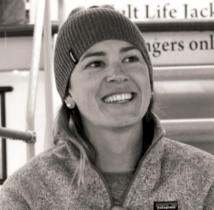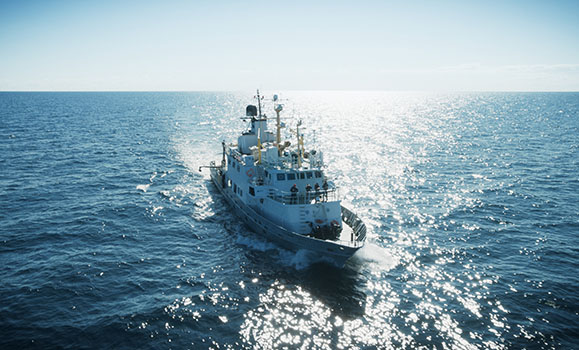It will be a mission of precision, patience and exacting co-ordination that could yield vital information about one of the ocean's most endangered, yet enduring mammals.Ěý
A team of researchers from ŐýĆ·Ŕ¶µĽş˝ set off earlier this week for the Shediac Valley, a 1,500-square kilometre expanse of ocean in the southern Gulf of St. Lawrence that is known to be a foraging ground for North Atlantic right whales.Ěý
 Once there, the group will scan the water's surface for signs of the slow-moving giants so they can start the intricate process of deploying tags on the animals that will capture data on the sounds, movements and location of one of the world's largest, most elusive creatures.Ěý
Once there, the group will scan the water's surface for signs of the slow-moving giants so they can start the intricate process of deploying tags on the animals that will capture data on the sounds, movements and location of one of the world's largest, most elusive creatures.Ěý
Their method? Drones that will drop the tags that attach with suction cups onto the back of the moving whale as it briefly breaks the surface in sometimes rolling seas.  

"Typically, we have at least four research crew that are actively part of the process," explains Dr. Sarah Fortune, an assistant professor in ŐýĆ·Ŕ¶µĽş˝'s Department of Oceanography who is co-leading the two-week mission with colleague Dr. Kimberley Davies from the University of New Brunswick.Ěý
Shown right: Dr. Sarah Fortune.
"We'll have two spotters on the wheelhouse who will have Bluetooth headsets, and on the stern we will have the drone pilot, then another responsible for releasing and catching the drone when it's brought back to the boat. There's a lot of patience involved in this because there has to be co-ordination to get a good tag attachment."Ěý
Below, watch a video of a drone deploying a tag:
Precision mission
Throughout the deployment, the team will be communicating through their headsets to co-ordinate the drop while those on the vessel's fly bridge talk to the captain to guide him on what his vessel speed and orientation should be.Ěý
"You become a well-oiled machine after a little while," she says with a laugh.Ěý
This is the second year that Dr. Fortune has used the drones to tag whales, but it is the first time her team will be doing it on its own after being trained on them last year by an expert with
Their work was featured in a full episode of , a new Apple TV+ documentary series that launched on July 11 and focuses on six of the world's most endangered animals.Ěý
It shows the delicacy and skill involved in deploying the tag as the drone hovers above before being dropped onto the back of an animal that can weigh up to 30 tonnes. Still, it is a far cry from their previous attachment method of using seven-metre-long carbon fibre poles with cantilever motion to apply tags.Ěý

The crew of “The Wild Ones” in the North Atlantic Ocean off the coast of Canada in “The Wild Ones,” now streaming on Apple TV+.
"I'm looking forward to the challenge, as long as the weather behaves then using the drone can be really efficient, even if it is difficult to keep track of the whales!" Jay Kirkum, a PhD candidate in Dr. Fortune's whale lab who will be piloting the drone this season, said from the crab boat being used by the team.Ěý
"Right whales are endangered and die almost exclusively because of human activity, so understanding their behaviour is so important in order for us to effectively protect them."Ěý
The human threat
There are only roughly 372 of the marine giants left and fewer than 70 reproductive females, a grim statistic for an animal that has been on the brink of extinction for decades due in large part to ship strikes and entanglements in fishing gear.Ěý
The research will focus on collecting detailed information about the underwater behaviour of whales to identify when and where they're feeding in the water column and what they're feeding on in terms of prey. To do that, they need to attach high-resolution biologgers — much like a kitted-out Fitbit — that record the whale's three-dimensional movement and acoustic vocalizations, along with a forward-facing camera that will give a whale's perspective underwater.Ěý
Once tagged, the team will follow the whale and continuously deploy oceanographic sensors throughout the water column to characterize its biological and physical characteristics. They will sample in their 'fluke prints,' which are the calm patches of circular water formed after the whale goes on a dive.Ěý
All of this data will help fill in important gaps in understanding the whale's locations, feeding habits, food source abundance and activities over a prolonged period of time.Ěý
If we know when and where whales are feeding, we can inform management decisions about human activities that present risks to whales
"If we know when and where whales are feeding, we can inform management decisions about human activities that present risks to whales, such as pot fishing and shipping," says Dr. Fortune, adding that the drone tagging mechanism they're using was built by the Dal-based Ocean Tracking Network.Ěý
Moira Brown, science director at the Canadian Whale Institute and chief scientist on board the vessel featured in the Apple TV+ whale episode, says the research will be invaluable for groups protecting the whales, researchers studying them and governments responsible for managing activities that intersect with whales.Ěý
"This tag is terrific because it can tell us what the whale does during the day and it's equipped with a cheeky little camera so you can get a visual," she said in an interview, adding that one of Dr. Fortune's tags stayed on for over 40 hours last year.Ěý
"It's hard to find whales at night, but her tag was recording dive profiles over a 38-hour period and this particular whale made shallower dives and spent more time on the surface and that is particularly important when it comes to vessel strikes."Ěý

